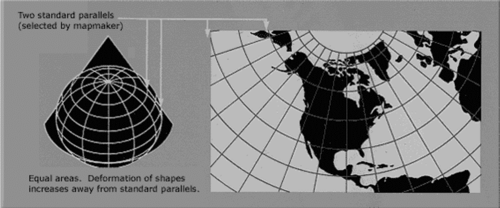Albers Equal Area Conic Projection
The Albers equal-area conic projection, is a map projection that uses two standard parallels to reduce some of the distortion of a projection with one standard parallel. Although neither shape nor linear scale is truly correct, the distortion of these properties is minimized in the region between the standard parallels. This projection is best suited for land masses extending in an east-to-west orientation rather than those lying north to south. It is used by the USGS for maps showing the conterminous United States (48 states) or large areas of the United States, as well as for many thematic maps.[1]

source: USGS
First developed by Heinrich Christian Albers in the early nineteenth century for European maps, its biggest success has been for maps of North America—specifically, for maps for the conterminous United States.[2]
The Albers projection is one of the standard projections for British Columbia, and is the sole standard projection used by the government of Yukon. It is also used by the United States Geological Survey and the United States Census Bureau. Snyder (Section 14) describes generating formulae for the projection, as well as the projection's characteristics. Coordinates from a spherical datum can be transformed into Albers equal-area conic projection coordinates with the following formulas, where λ is the longitude, λ0 the reference longitude, φ the latitude, φ0 the reference latitude and φ1 and φ2 the standard parallels.[3]
The Albers Area Projection Fomulae[4]
Let phi_0 be the latitude for the origin of the Cartesian coordinates and lambda_0 its longitude, and let phi_1 and phi_2 be the standard parallels. Then for a unit sphere, the Albers equal-area conic projection maps latitude and longitude (phi,lambda) to Cartesian (x,y) coordinates
x = rhosintheta y = rho_0-rhocostheta,
where
n = 1/2(sinphi_1+sinphi_2) theta = n(lambda-lambda_0) C = cos^2phi_1+2nsinphi_1 rho = (sqrt(C-2nsinphi))/n rho_0 = (sqrt(C-2nsinphi_0))/n.
The projection illustrated above takes (phi_0,lambda_0)=(0 degrees,0 degrees) and standard parallels at phi_1=0 degrees and phi_2=60 degrees.
The inverse formulas are
phi = sin^(-1)((C-rho^2n^2)/(2n)) lambda = lambda_0+theta/n,
where
rho = sqrt(x^2+(rho_0-y)^2) theta = tan^(-1)(x/(rho_0-y)).
References
Further Reading
- Albers Equal Area Conic ArcGIS Desktop
- Europe Albers Equal Area Conic Spatial Reference
